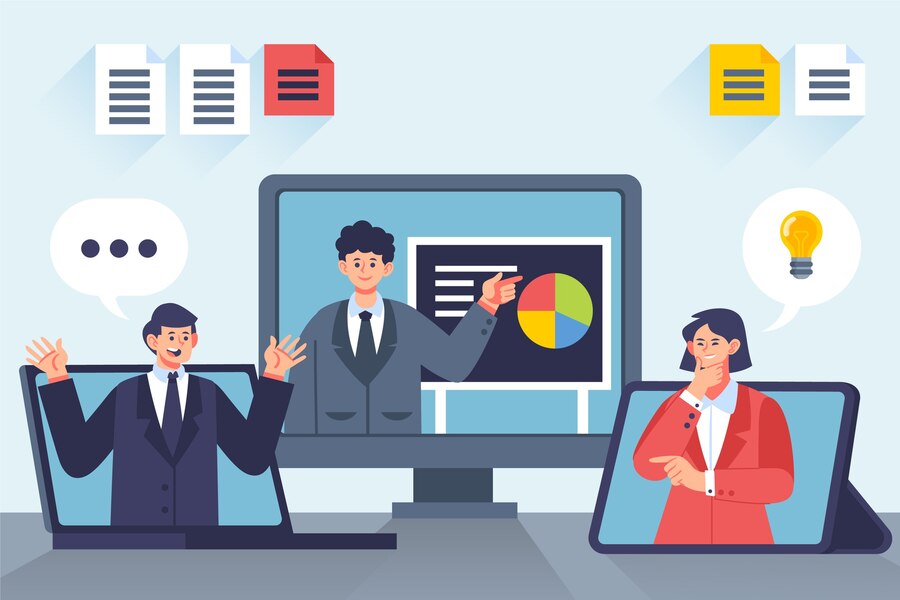How To Upscale Your Business With A Microsoft Teams Training Plan
5 Mins Read
Published on: 05 January 2023
Last Updated on: 10 September 2024

toc impalement
Whenever an improvement to the usual workplace protocols, such as communications and productivity technology, is implemented, retraining is always essential. A crucial component of the Microsoft Teams Adoption Strategy is the training plan.
You need to show your clients what to do with new technology and how to apply it to their jobs through a variety of scenarios. It’s crucial to offer your staff a variety of tools that could enhance their efficiency and ability to work together.
Strategy and sponsorships, application cases, governance, KPIs, analytics, and a strategic communication approach are all essential components in the adoption of Microsoft Teams. Here are some tips, ideas, samples, and resources that can be used to make the best Microsoft Teams training that is tailored to your target audience.
What Is A Training Plan?
A training plan is a complete set of instructions to a personnel or worker given through a methodical, systematic approach. Its goal is to give staff members the abilities and information they need to take on new responsibilities to perform at work.
A training program is a crucial part of adopting Microsoft Teams. Make sure your personnel or workers are capable of using the latest software and adapting it to suit particular job responsibilities.
Formats
Training should not be dull and unappealing, as many people believe. You can use a wide range of formats to start making the training exciting and compelling.
A variety of training formats should be used to accommodate various learning preferences, geographic restrictions, and resource limitations. An excellent choice is interactive and collaborative training.
It should include conversations in small groups, tests, games, demonstrations, and presentations. You may promote learning and passion for using technology by promoting dialogues and group dynamics.
Additionally, experiment with fusing online conferences with in-person meetings at coffee shops, or even outside if the conditions allow. Giving your staff the chance to change up their typical work and learning atmosphere can motivate them to take initiative, and assist in their training. It is like providing a breather from a normal daily routine.
Expectedly, a few of your staff members will find it harder compared to others to switch from their typical working methods to Teams. Conducting special coaching sessions for these groups of employees can enable them to still be confident in doing their tasks.
Good Practices

1. Continuous Training
Learning doesn’t stop. Each time a new function is released, it must be made sure that everyone in the users is aware of it for you to fully utilize Teams’ possibilities. Continue giving your team ongoing training.
2. Executive Sponsor Engagement
Be sure to participate in the key training session as the executive sponsor. This will reinforce the program’s significance in the organization’s purpose and grant it more credibility and support.
3. Entertaining Formats
Make every effort to keep your audience-specific training materials dynamic, enjoyable, and tailored.
4. Peer Learning
Make training foster an atmosphere where everybody feels welcome and at ease to openly share perspectives, and experiences, and ask questions. It has been proven to be quite beneficial. Create a user community so that your staff members can share knowledge and experiences.
5. New Hires’ Training
Ensure training for new hires, especially Microsoft Teams training. Integrate the onboarding with the training.
6. High-Value Use-Cases
Concentrate on communicating to your personnel various application scenarios that are simple to comprehend and those more valuable than solutions that are currently in use.
7. Measuring Success
Maintain a close eye on the aspects of strength and weakness and adjust your training program as necessary.
8. Listening To Your Audience
Consider your target audience when developing your training materials and formats. Prioritize how you want to assist your users. Analyze the values of the organization, the intricacy of the solutions, and past training techniques they have undergone as well.
Keep In Mind
Take into account the equipment that your company already employs. Extra training measures should be required if your company is using different technology because it will call for users to modify their actions.
Determine how tech-savvy you think your staff is. The level of digital literacy of your workers will influence how quickly they accomplish the training, as well as how easily they adapt to the modified working environment.
Take into consideration the technology which your personnel is presently using. Be sure that they are not overloaded with several tools, and allow them enough time to process new knowledge.
Understand the preferred approaches to learning your workforce. It could be a team or individual session, an indoor or outdoor meeting, a computer-based training, or an on-site training.
When creating a company training plan, there’s a good chance that you will run into language barriers if your company has offices abroad. Consider these difficulties and be sure to customize the instruction to the diverse culture of each workplace.
Learning strategies are always changing. Consider these patterns as you work to continually improve your training methods.
Scaling
Training should be divided into phases that will ultimately lead to widespread adoption. To achieve progressive acceptance, you must target various user groups at various times.
Educate your Core Team first. Project managers and executive sponsors are the main individuals involved in developing and executing your Microsoft Teams Adoption program.
Then, pay attention to the IT preparations. Ensure that your technical staff has the necessary credentials and has completed the administration program.
The next sequence outlined in the adoption plan is to focus on particular Business Departments inside your company. Numerous approaches can be employed to instruct this group.
Finally, plan frequent training sessions to ensure ongoing learning and thus keep up with current updates of the product and its future expanded capabilities.
Read Also: Microsoft Teams Calling for Business: What You Should Know
Conclusion
There are excellent platforms available that would let you learn more or study up on your understanding of a wide range of subjects across all relevant industries. LinkedIn Learning, Udemy, Mandarine Academy, KnowledgeWave, LMS365, and Global Knowledge are just a few of the online resources that can be accessed.
You may learn how to utilize many other Microsoft programs, like Excel, Word, Outlook, One Note, and many others, that are compatible with Teams. It is a learning tool that is a part of Teams and Microsoft 365.
IT training module on quality standards for Office 365 Adoption, on-demand instructional materials including videos, and live interactive online classes are also available. Some of these platforms may require subscription or enrollment.
Read Also:


















Comments Are Closed For This Article